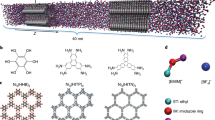Abstract
In the spirit of the theoretical evolution from the Helmholtz model to the Gouy-Chapman-Stern model for electric double-layer capacitors, we explored the effect of a diffuse layer on the capacitance of mesoporous carbon supercapacitors by solving the Poisson-Boltzmann (PB) equation in mesopores of diameters from 2 to 20 nm. To evaluate the effect of pore shape, both slit and cylindrical pores were considered. We found that the diffuse layer does not affect the capacitance significantly. For slit pores, the area-normalized capacitance is nearly independent of pore size, which is not experimentally observed for template carbons. In comparison, for cylindrical pores, PB simulations produce a trend of slightly increasing area-normalized capacitance with pore size, similar to that depicted by the electric double-cylinder capacitor model proposed earlier. These results indicate that it is appropriate to approximate the pore shape of mesoporous carbons as being cylindrical and the electric double-cylinder capacitor model should be used for mesoporous carbons as a replacement of the traditional Helmholtz model.
Similar content being viewed by others
References
B.E. Conway Electrochemical Supercapacitors: Scientific Fundamentals and Technological Applications(Kluwer Academic/Plenum, New York 1999)
J.R. Miller, P. Simon: Fundamentals of electrochemical capacitor design and operation. Electrochem. Soc. Interf.17, (1) 31 (2008)
M. Winter, R.J. Brodd: What are batteries, fuel cells, and supercapacitors≟ Chem. Rev.104, (10) 4245 (2004)
A. Burke: Ultracapacitors: Why, how, and where is the technology. J. Power Sources91, (1) 37 (2000)
R. Kötz, M. Carlen: Principles and applications of electrochemical capacitors. Electrochim. Acta45, (15-16) 2483 (2000)
A.G. Pandolfo, A.F. Hollenkamp: Carbon properties and their role in supercapacitors. J. Power Sources157, (1) 11 (2006)
E. Frackowiak: Carbon materials for supercapacitor application. Phys. Chem. Chem. Phys.9, (15) 1774 (2007)
P. Simon, Y. Gogotsi: Materials for electrochemical capacitors. Nat. Mater.7, (11) 845 (2008)
L.L. Zhang, X.S. Zhao: Carbon-based materials as supercapacitor electrodes. Chem. Soc. Rev.38, (9) 2520 (2009)
J. Lyklema Fundamentals of Interface and Colloid Science, Volume II: Solid-liquid Interfaces(Academic Press, San Diego, CA 1995)
J. Huang, B.G. Sumpter, V. Meunier: Theoretical model for nanoporous carbon supercapacitors. Angew. Chem. Int. Ed.47, (3) 520 (2008)
J. Huang, B.G. Sumpter, V. Meunier: A universal model for nanoporous carbon supercapacitors applicable to diverse pore regimes, carbon materials, and electrolytes. Chem. Eur. J.14, (22) 6614 (2008)
H. Gerischer: The impact of semiconductors on the concepts of electrochemistry. Electrochim. Acta35, (11-12) 1677 (1990)
C.L. Rice, R. Whitehead: Electrokinetic flow in a narrow cylindrical capillary. J. Phys. Chem.69, (11) 4017 (1965)
A.J. Bard, L.R. Faulkner Electrochemical Methods: Fundamentals and Applications(John Wiley & Sons, New York 2001)
M.J. Mitchell, R. Qiao, N.R. Aluru: Meshless analysis of steady-state electro-osmotic transport. J. Microelectromech. Syst.9, (4) 435 (2000)
D. Lozano-Castelló, F. Suárez-García, D. Cazorla-Amorós, A. Linares-Solano:: Porous texture of carbons, Carbons for Electrochemical Energy Storage and Conversion Systemsedited by F. Beguin and E. Frackowiak (CRC Press/Taylor & Francis Group, Boca Raton, FL 2009)115–162
C.J.E. Farina, K.B. Oldham: The diffuse charge region in thin layer cells. J. Electroanal. Chem.81, (1) 21 (1977)
W-Y. Lo, K-Y. Chan, M. Lee, K-L. Mok: Molecular simulation of electrolytes in nanopores. J. Electroanal. Chem.450, (2) 265 (1998)
O. Barbieri, M. Hahn, A. Herzog, R. Kötz: Capacitance limits of high surface area activated carbons for double layer capacitors. Carbon43, (6) 1303 (2005)
J. Chmiola, G. Yushin, Y. Gogotsi, C. Portet, P. Simon, P.L. Taberna: Anomalous increase in carbon capacitance at pore size less than 1 nanometer. Science313, (5794) 1760 (2006)
C. Vix-Guterl, E. Frackowiak, K. Jurewicz, M. Friebe, J. Parmentier, F. Béguin: Electrochemical energy storage in ordered porous carbon materials. Carbon43, (6) 1293 (2005)
M. Sevilla, S. Alvarez, T.A. Centeno, A.B. Fuertes, F. Stoeckli: Performance of templated mesoporous carbons in supercapacitors. Electrochim. Acta52, (9) 3207 (2007)
C. Liang, K. Hong, G.A. Guiochon, J.W. Mays, S. Dai: Synthesis of a large-scale highly ordered porous carbon film by self-assembly of block copolymers. Angew. Chem. Int. Ed.43, (43) 5785 (2004)
Author information
Authors and Affiliations
Corresponding author
Rights and permissions
About this article
Cite this article
Huang, J., Qiao, R., Sumpter, B.G. et al. Effect of diffuse layer and pore shapes in mesoporous carbon supercapacitors. Journal of Materials Research 25, 1469–1475 (2010). https://doi.org/10.1557/JMR.2010.0188
Received:
Accepted:
Published:
Issue Date:
DOI: https://doi.org/10.1557/JMR.2010.0188




